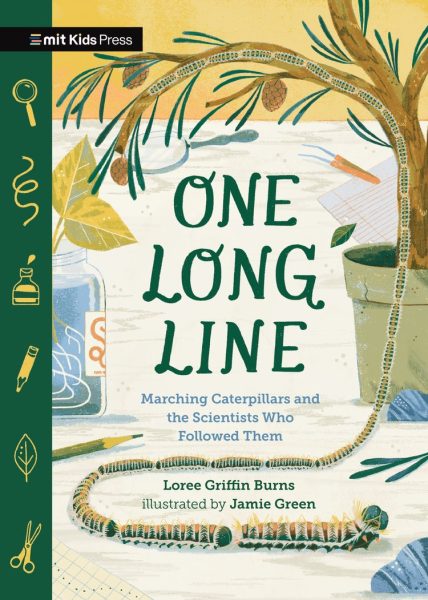
Summary
The first title in a brand-new early chapter book series from Loree Griffin Burns, Jamie Green, and MITKids spotlights remarkable creatures, inquisitive people, and fascinating conversations. The creatures? Processionary caterpillars with mysterious group marching habits. The people? Jean Henri Fabre and, many years later, Terrence Fitzgerald—scientists who became intensely curious about the caterpillars and their marching. And the conversations? They span lifetimes, as one researcher continues a dialogue started by the other. In this playful, candid, and accessible book for young readers, Burns pulls readers straight into the “ask, test, repeat” nature of the scientific process, demonstrating how human curiosity creates one long line of learning.
- MIT Kids Press, 2024
- 64 pages
- For ages 7-10
Honors
- Junior Library Guild Selection
Reviews
School Library Journal, May 24, 2024, Starred Review
Booklist, March 15, 2024, Starred Review
Hungry pine processionary caterpillars can travel considerable distances when they’re searching for food, and they always make these journeys in long, single-file lines. This engaging offering documents the research of two scientists who became fascinated by these unique behavior patterns, even though the men lived in different countries at different times. Jean-Henri Fabre was French and died in 1915; Terrence Fitzgerald is American and was born in 1941. The text carefully lays out how each researcher conducted careful observations, formulated specific questions and hypotheses, and devised ingenious experiments to test their hypotheses. While the “long line” reference in the title alludes to the caterpillar processions, it also speaks to how one discovery led to additional lines of questioning and how Fitzgerald’s research followed the path laid out by Fabre and other nineteenth-century entomologists. The text is particularly engaging, and is supported by numerous sidebars, illustrations, and rich back matter that will be extremely helpful for report writers. This engaging STEM offering has applications that cross curricular areas, provides accessible models of how scientific inquiry works, and introduces a couple of pretty cool scientists as well as a plethora of caterpillars.~ Kathleen McBroom
Eliot Schrefer, author of Printz Honor Book Queer Ducks (and Other Animals): The Natural World of Animal Sexuality
One Long Line captures the endless fascination ordinary creatures offer if we ask them the right questions. I can imagine a generation of young scientists beginning their journeys by reading this book. A remarkable and inspiring start to an important new series.

